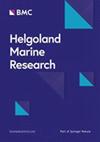Population genetics of Bursatella leachii (De Blainville, 1817) and implications for the origin of the Mediterranean population
4区 地球科学
Q2 Agricultural and Biological Sciences
引用次数: 11
Abstract
The sea hare Bursatella leachii (de Blainville 1817) (Mollusca: Gastropoda: Heterobranchia: Aplysiidae) is a pantropical sea slug that has colonized the Mediterranean Sea in modern times. Because the initial records in the non-native range started in the Eastern Mediterranean, and its pattern of spread was relatively consistent with those observed in well-known Lessepsian invaders, B. leachii is commonly considered to be a migrant from the Red Sea. In this study, we investigate for the first time the origin of the Mediterranean populations of B. leachii inferring their population structure and assessing relatedness levels of different regional populations. Sequence data from the cytochrome oxidase I were used to conduct population genetic analyses on this species, particularly by investigating the genetic structure of Atlantic, Mediterranean, and Indo-Pacific populations. Our results confirm that B. leachii is a truly pantropical species which displays geographic structure among major ocean basins. More importantly, sequenced Mediterranean and Atlantic animals share similar or identical haplotypes, which are distinct in at least 5 substitutions from haplotypes recovered from Indo-Pacific specimens. The results suggest that the Mediterranean population of B. leachii here examined probably have an Atlantic origin, and for the first time casts doubts on the assumed primary pathway of migration into the Mediterranean Sea.leachii bur卫星的种群遗传学(De Blainville, 1817)及其对地中海种群起源的影响
海蛞蝓(de Blainville 1817)(软体动物目:腹足目:异鳃目:海蛞蝓科)是一种泛热带海蛞蝓,在近代定居在地中海。由于在非本地范围的最初记录始于地中海东部,其传播模式与在众所周知的利塞普西亚入侵者中观察到的模式相对一致,因此通常认为B. leachii是来自红海的移民。在这项研究中,我们首次调查了leachii B.地中海种群的起源,推断了它们的种群结构,并评估了不同区域种群的亲缘关系水平。细胞色素氧化酶I的序列数据被用于对该物种进行种群遗传分析,特别是通过调查大西洋、地中海和印度-太平洋种群的遗传结构。本研究结果证实了leachii是一个真正的泛热带物种,在主要的海洋盆地之间具有地理结构。更重要的是,测序的地中海和大西洋动物具有相似或相同的单倍型,与从印度-太平洋标本中恢复的单倍型至少有5个不同的替换。研究结果表明,地中海地区的leachib种群可能起源于大西洋,并首次对假定的地中海主要迁徙途径提出了质疑。
本文章由计算机程序翻译,如有差异,请以英文原文为准。
求助全文
约1分钟内获得全文
求助全文
来源期刊

Helgoland Marine Research
地学-海洋学
自引率
0.00%
发文量
0
审稿时长
6-12 weeks
期刊介绍:
Helgoland Marine Research is an open access, peer reviewed journal, publishing original research as well as reviews on all aspects of marine and brackish water ecosystems, with a focus on how organisms survive in, and interact with, their environment.
The aim of Helgoland Marine Research is to publish work with a regional focus, but with clear global implications, or vice versa; research with global emphasis and regional ramifications. We are particularly interested in contributions that further our general understanding of how marine ecosystems work, and that concentrate on species’ interactions.
 求助内容:
求助内容: 应助结果提醒方式:
应助结果提醒方式:


